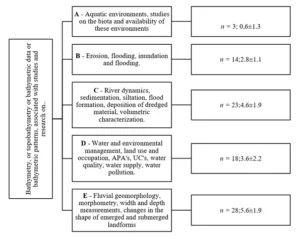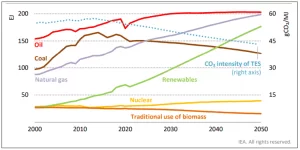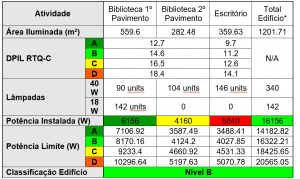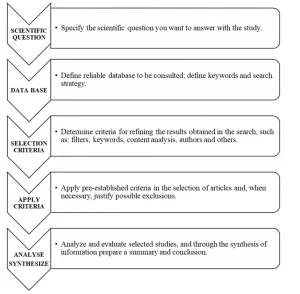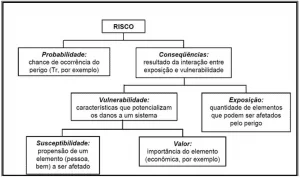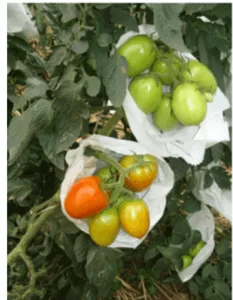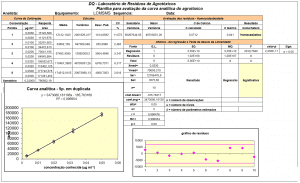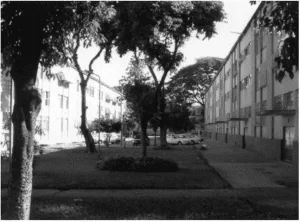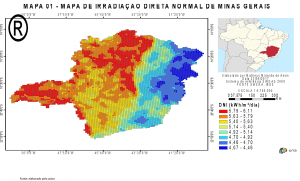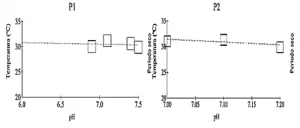ORIGINAL ARTICLE
MOREIRA, Samya de Freitas [1], SANTOS, Sara Dorea de Oliveira [2], SILVA, Raiane Ferreira [3], LOBO, Ronilson Rosário [4], JESUS, Edmir dos Santos [5], JÚNIOR, Antônio Pereira [6]
MOREIRA, Samya de Freitas. Et al. Positive and negative externalities due to the advance of sojiculture. Revista Científica Multidisciplinar Núcleo do Conhecimento. 04 year, Ed. 12, Vol. 03, pp. 91-113. December 2019. ISSN: 2448-0959, Access link in: https://www.nucleodoconhecimento.com.br/environmental-engineering-en/externalities-positive
SUMMARY
Externalities have positive or negative effects because they generate costs or benefits for society. The aim of this study was to conduct a quantitative-qualitative research, for evidence in relation to externalities and the advancement of sojiculture, in the municipality of Paragominas, and, with this, generate data that allow an adequate balance. The method applied was the inductive, with quantitative qualitative approach, associated with the survey of documentary data with time frame between 2008 and 2016, due to the implementation of the Green Municipality Project in 2008. The analysis of the obtained data indicated that there was an evolution in the soybean planted area (52,520 ha to 239,163 ha) in the three three-year periods analyzed (2008-2010; 2011-2013; 2014-2016), also indicated that there was an advance in agricultural GDP (R$ 101,605,000.00 to R$ 278,493,000.00), and consequently, an increase in municipal GDP (R$ 4,290,238,000.00 to R$ 6,684,730,690.00), qualified as positive externalities. However, it resulted in negative externalities, such as deforestation, which increased from 2,555,710 ha in (2008-2010) to 2,619,570 ha in (2014-2016). Therefore, this situation of negative externalities can be circumvented with the application of sustainable techniques (e.g., no-tillage technique; inoculation of seeds for Biological Nitrogen Fixation (BNF) in the soil, as well as the use of areas of deforested.
Keywords: Deforestation, no-tillage, income, agricultural sector, soybeans.
1. INTRODUCTION
Externality is a market failure, and can be understood as a cost or benefit, resulting from the production of an economic good, or from the consumption of goods and services, which focuses on third parties, with the exception of producers. It originates, in this case, from production or consumption, and can be positive, when it generates a benefit, and negative, when it entails a cost (ALMEIDA, 2013; ANTUNES, 2009; MIRANDA, 2014). Soybean monoculture, for example, lacks further analysis, as it is a potentially producing activity of positive and negative externalities (BALBINOT JUNIOR et al., 2017).
The Brazilian evolutionary process of sojiculture began in 1941, when this culture acquired the first national reference of commercial production in Brazil, with the cultivation of 450 tons. Eight years later, Brazil raised production to 5,651.33%, with 25,881 tons in 1949, when it acquired its first international record as a producer. Ten years later, soybean swell swelled from 151,574 tons, and in the following decade, to 1,056,607 tons, an increase of 597.09%. From this, soybeans have definitely established itself as an economically important crop for the country (EMBRAPA, 2015).
However, in 1970, less than 2% of national production was harvested in central Brazil. However, in 1980, this percentage increased to 20%, in 1990 it was already more than 40% and, in 2011, the contribution was 60%, and with tendencies to occupy more space with each new crop. As a reflection of this productivity advance in the country, Brazil ranks second to largest producer of oilseeds, with little difference in production, and with this happens only the United States (DALL’AGNOL, 2011).
In other words, soybean cultivation is the exponent of Brazilian agribusiness, and the continuous expansion begins to draw attention to the effects that derive from this production. The externalities generated by soybean monoculture are not limited to those directly related to the areas destined to such crop (FIRMINO; FONSECA, 2008).
Moreover, when considering that there are by-products (goods of public interest generated by agricultural activity), resulting from agricultural activity, with special attention to soybean monoculture, these by-products should be understood as externalities. It is essential to arrive at a model of remuneration of externalities, either by subsidies from the government, or by the increase in the prices of such articles (GRANZIERA; SAES, 2014).
In relation to positive externalities, sojicultura stands out for its political weight, therefore, it promotes the implementation of infrastructure works in the region from the so-called “drag effect”, which consists in attracting other activities and/or investments to the region (BRUM; DALFOVO, D.A. BENFICA, 2011).
Certainly, the growth of the sectors involved with soybeans, from the expansion of agricultural areas, technologies and investments in processing industries, provide positive results for the population of cities, such as the generation of more jobs, more investment in education and professional training, consequently, there are better sources of income and services (DERANI; SCHOLZ, 2017).
As for negative externalities, biomes and biodiversity are directly affected by the expansion of soybean monoculture. Intensive agriculture, especially that linked to agribusiness of this oilseed, increases the participation in the conversion of native vegetation cover. With the increase in soybean production, caused by the greater incentive of the government, the planted area also increased (33 million tons in 2000 to 95 million tons in 2016, an increase of 187.88%), which causes the increase in deforestation and, with it , damage to the environment (SOUZA; ROCK; RIBEIRO, 2013).
As a result, biodiversity loss is the main environmental response to deforestation and is also totally irreversible when there is co-evolution, that is, an interdependent evolution of species. Deforestation destroys habitats of various animal and plant species, and puts their existence at risk (ARAÚJO, 2014).
In addition, studies (NOBRE et al., 2009; SANTOS et al., 2011), reinforce the thesis, that the advance of soybeans and the conversion of vegetation cover can cause serious hydrological and regional climate changes, such as increased temperature, changes in rainfall patterns and changes in availability of water. Soybean monoculture can also cause soil impoverishment and contamination, due to the indiscriminate use of fertilizers and pesticides (DEUS; BAKONYI, 2012).
Therefore, the advance of sojiculture causes positive and negative externalities that need to be studied, which justifies this research, whose relevance is increased by the elaboration of information necessary to stimulate positive externalities and minimize the negative and, finally, achieve the objective, which is to conduct a quantitative qualitative research, in relation to externalities in the municipality of Paragominas, and the advancement of sojiculture, besides generating data that allow an adequate balance.
2. LITERATURE REVIEW
In Brazil, soybeans have been the fastest growing crop in cultivated area, and the extraordinary expansion of production in the last 20 years is explained by the increase in planted area and productivity (KUPLICH, CAPONE; COSTA, 2018). This cultivated area increased by 378.5% and productivity advanced 64.2% in the decades from 1970 to 2000 (PAMPLANA, 2017). As a result, oilseeds provide great capacity to the Brazilian agricultural sector, due to the territorial importance (27.7 million hectares planted in 2012/2013, equivalent to 52% of temporary crops), although it has not always been so (ARAÚJO; BRIDGE, 2015).
This was due to the gradual migration to Paraná, expanded to the midwest, initially through Mato Grosso do Sul, and later to other states (GAZZONI, 2013; MR. SILVA; RODRIGUES, 2016). According to data from the National Supply Company – CONAB (OLIVEIRA NETO, 2017), currently, five states located in the South-Central Region of Brazil (Goiás, Mato Grosso, Mato Grosso do Sul, Paraná and Rio Grande do Sul) concentrate 75% of the area cultivated with (25.8 million hectares) and 77% of national production (79.25 million tonnes).
The consequence of this migration has become the important role for the development of municipalities, as occurs in Sorriso – MT, which presents good socioeconomic indices, such as the passage of per capita income from approximately R$ 7,846.00 in 1999 to R$ 25,935.00 in 2005. This economic growth can also be noticed in relation to gross domestic product – GDP and, according to the Mato Grosso Department of Finance, it was R$ 207 million in 1998, reaching R$ 706 million in 2003, which means a growth of 342% in five years. Of this total, soybeans participate with 40% and, considering the entire primary sector of the municipality, this participation grows to 60% (FREDERICO, 2011; GIARETTA, 2017).
This can be seen by the expansion of the soybean-sed area, which grew, in relation to the total area of the municipality, from 40.7% in 2000 to 63.7% in 2006. However, part of deforestation in Sorriso is directly due to the planting of oilseeds, which occupies the second place among the municipalities of Mato Grosso with the highest percentage of deforestation, equivalent to 68.3%. The deforested area in Sorriso between 2000 and 2006 corresponded to 12.17% of the total area of the municipality (BRUM, DALFOVO; AZUAGA, 2009).
In the municipality of Sinop – MT, soybeans contributed positively to other sectors also to present progress, such as the industrial and services sector, which had, respectively, in 2004 a share in the gdp of the municipality, in R$ 95,535.00 and R $347,529.00 (BRUM; DALFOVO, D.A. BENFICA, 2011).
Another municipality, Cristalina – GO, is one of the largest soybean producers (1st in the state ranking and 6th in the national) and the increase in GDP, in addition to the consequent insertion in the national and international market, gave status to the city. The implementation of physical storage structures aiming to accommodate the final product of plantations, generated the insertion and social transformation, since these measures create jobs that can absorb part of the marginal proletarian, in order to intensify the sector local economic economy (FERNANDES; PESSÔA, 2011).
Driven by the soybean superharvest, agriculture in Rio Grande do Sul – RS evolved in 2013, and the State recorded the second highest agricultural GDP in Brazil (12% of the Brazilian total), and was only behind Paraná (12.5%). It was a significant advance in relation to 2012, when Rio Grande do Sul contributed 8.1% in the generation of wealth in the first sector. The performance improvement also ensured the overtaking (in the annual production ranking) of other states, traditionally ahead of rs, such as Mato Grosso, Minas Gerais and São Paulo (BORGES; SIMONS; TRINDADE, 2016).
However, the rapid growth of soybean production is accompanied by several problems in the social area and, mainly, in the environmental area, since the expansion of sojícola demand reaches the Amazon biome, one of the richest in biodiversity on the planet, and generates concern not only for Brazilian society, but also for the countries consuming this production (MANGATTO JUNIOR; OLIVE TREE; SILVA, 2017; RIVERO et al., 2009).
In the Amazon context, especially in the case of Santarém – PA, the land that gives rise to the productive expansion of soybeans on a large scale, may be the land degraded by the pastures previously established, the land speculated by large producers of the mechanized agriculture, or it may even be the native forests that, although untouched by man, have been the most used recently, due to the scarcity of land suitable for production closer to the centers of flow (ARAÚJO; BRIDGE, 2015). As a result, soybeans, combined with cattle raising and logging are the largest vectors of deforestation (MAGNO et al., 2013).
In this municipality, the impacts on the waters are seen daily, arms of important rivers and streams have already disappeared or are in the process of being ensoreamento, wild animals are also disappearing or invading urban areas. The illegal planting of soybeans on the springs destroys the water sources and causes the volume of soybeans to be reduced, and thus leads to various environmental crimes (BROCHADO, 2017; OLIVE TREE; SANTANA, 2012).
As a result, soybeans pose a powerful threat to Amazonian biodiversity, as it justifies large transport infrastructure projects, which in turn initiate a chain of events leading to the destruction of natural habitats in extensions, in addition to the areas planted directly with soybeans. Such facts make soy much more harmful to the environment than other crops (DOMINGUES; BERMANN, 2012)
Therefore, the migration of soybean cultivation from northern Mato Grosso to the south of the Amazon region has caused numerous climate changes. Studies (ARTAXO et al., 2014; GONZALES et al., 2013; NOBRE et al., 2009; SANTOS et al., 2011) reveal that this is due to the rampant deforestation of the Biome forests, and much is due to the advance of soybeans. Therefore, the thesis is reinforced that, with the advance of soybeans and deforestation of immense areas, the climate in the region is directly affected and abruptly alters the rainy periods and other variables associated with this (SANTOS, C; SATYAMURTY; SANTOS, E. 2012).
Such changes also occurred in the Cerrado biome and altered the ecosystem structures of the region, where native vegetation is replaced by soybean crops or dry and acidic soil, in addition to undergoing transformations to adapt to receive planting, which harms the subsistence exploitation of families living off the natural resources offered by the Cerrado Biome, such as ornamental and medicinal plants, cerrado fruits, etc. (QUEIROZ, 2009).
In addition, a study (IRIGARAY et al., 2011) conducted in the Upper Paraguay Basin, which houses the Pantanal biome, stated that the floodplain of this biome has a relationship of interdependence with the ecosystems located around it. Therefore, any changes can become a threat to the biodiversity of the Pantanal system, such as the use and occupation of soil in this biome, which has a large soybean production. However, even with the ecological importance of the Pantanal, until 2004, 44% of the native coverage area of the Upper Paraguay Basin was changed.
Another problem occurred in Goiás, where soil genetic impoverishment is the most critical in agricultural practices in force in this Cerrado region, which generally focus on soybean monoculture, which gradually makes the soil infertile and unsuitable even for soybean agricultural production. The introduction of invasive species in the region, in a negative way, alter the present natural system, which promotes the appearance of pests and diseases, which affect not only natural resources, but also agricultural production (MATOS; PESSÔA, 2012).
Moreover, in the municipality of Cristalina, in the same state, oilcrops generate irremediable damage to the water wealth of the region, because, in addition to indiscriminately using water reserves, they still harm with pollution caused by application of agricultural inputs and pesticides, which are dumped by irrigation equipment in crops, in order to intensify production. These same products that correct soil nutritional deficiency and also fight pests, when they fall into the soil are absorbed and reach the groundwater and, in some cases, the springs of the water springs (ABDALA; RIBEIRO; FERREIRA, 2016).
Just to illustrate: land issues add to the effects of productive specialization in soybeans. The average annual growth in the number of conflicts in the field was 7.64% between 1990 and 2013. In fact, the occupation of territories for soybean cultivation puts pressure on forest reserves, as well as areas destined for small agriculture and plant extraction, occupied by family farmers, indigenous peoples and other traditional peoples (CPT, 2016).
In Pará, although soybeans were initially planted in degraded areas in the Baixo Amazonas region, cases of processed plantations are observed on top of areas of felled or burned forests. In fact, in this region soybean also reached areas traditionally occupied by family farmers, in which acquisitions and expulsions from the land occurred, in a process of replacing the original crops, such as corn, beans, macaxeira, fruits and vegetables (SILVA, 2008).
With the help of Greenpeace, local communities have been able to identify the impacts of soybeans in the western state of Pará. Local authorities question the development of the region with the arrival of soybeans, in view of the numerous negative impacts identified, such as urban degradation, lack of a hospital that covers the entire city and poor quality education (OLIVEIRA; SANTANA, 2012).
In Cristalina – GO, the rural worker who was expelled from the camp due to the use of machinery, causes the rural exodus and swelling in the city, which does not have the physical or social structure to welcome this disqualified workforce. Therefore, they are considered marginal proletarians, who need and create new ways of surviving, influence informal trade, the number of unemployed, homeless, and consequently, the increase in urban violence (FERNANDES; PESSÔA, 2011).
These scenarios facilitate the understanding of the positive and negative externalities caused by the expansion of soybean agribusiness, which adversely to the good results obtained financially, imposes considerable environmental costs in a continuous process of degradation (DELAZERI, 2016).
3. METHODOLOGY
3.1 METHOD
For the elaboration of this study, the summaries written by five researchers about the exposures on research methods were applied (Chart 1).
Table 1 – The search methods used.
| Researcher | YEAR OF PUBLICATION | Methods | Features |
| Silveira, I have one of them. Cordoba | 2009 | Inductive | It starts from the observation of facts or phenomena whose causes one wishes to know. Particularly, in the municipality of Paragominas, soybean expansion was studied as an increase in local deforestation. |
| Prodanov, New Year;10; French | 2013 | Quantitative-qualitative approach | The joint use of quantitative and qualitative research allows collecting more information than could be achieved in isolation, by generating data coverage and greater understanding about the problems studied. |
| Sakamoto, Sakamoto; Scott | 2014 | Applied nature | It seeks to generate knowledge for practical application, oriented to the solution of specific problems by involving local truths and interests. |
| Severino | 2017 | Exploratory procedure | It is proposed to provide greater familiarity with the research problem, in order to make it more explicit, it may involve bibliographic survey, interviews with people experienced in the researched problem and analysis of examples that stimulate understanding. |
Source: Authors (2019).
The following information bases were consulted: (1) Brazilian Institute of Geography and Statistics (IBGE), where information was collected about the agricultural production of soybean crops in Paragominas, which involved the value of production, the production in tons (t.) and planted area (ha), calculated by the Municipal Agricultural Survey, (2) National Institute of Space Research (INPE), based on the Digital Amazon Deforestation Program (PRODES), for the survey of information on deforestation in the municipality and (3) National Water Agency (ANA), based on the electronic portal HidroWeb, to collect data on the total annual precipitation.
As a basis for the Literature Review, scientific journals available in the following information bases were used: (4) portal of the Coordination for the Improvement of Higher Education Personnel (CAPES); (5) bibliographic database of Scientifc Electronic Library Online (SciELO) and (6) Google Scholar.
For the analysis of the relationship “deforested area and the increase of the planted area of soybean crop”, the methodology used by Rivero et al was applied. (2009). This analysis was carried out in the years 2008 to 2016, and the deforestation rates observed for the same period. The analyses involved pearson correlation studies between these variables, with the objective of confirming or not, the existence of it, among these variables.
The data obtained were organized in tabular arrangement and statistically treated with the use of spreadsheets contained in the Microsoft Excel software (2016) and pearson correlation, with values for r, obtained with the use of spreadsheets elaborated to from the Software BioEstat – version 5.3 (AYRES et al., 2007), and use of the scale (Table 01) used by Porto; Jesus, Jesus, Jesus, Jesus; Pereira Junior (2017). From the organization of the data, graphs were elaborated with originpro 9 software. 64 (2012), to demonstrate the interaction between the variables studied. And, regarding the elaboration of the tables, they were elaborated in spreadsheets contained in the Microsoft Word software (2016).
Table 1 – Scale used to characterize the type of correlation between the variables.
| Pearson correlation (r) | Relationship |
| 0 | Nonexistent |
| 0,10 – 0,30 | Weak |
| 0,40 – 0,60 | Moderate |
| 0,70 – 1,00 | Strong |
Source: Porto; Jesus, Pereira Junior (2017).
3.2 AREA OF STUDY
The research was carried out in the municipality of Paragominas (Figure 01), located in the Southeast region of the State of Pará and located at 02º59’08” S and 47º19’57” W. The area of the municipality is equivalent to about 19,342.254 km² and the population is estimated at 110,026 inhabitants, with a population density of 5.69 inhabitants/km² (IBGE, 2017a).
Figure 1 – Map of the location of the municipality of Paragominas – PA.
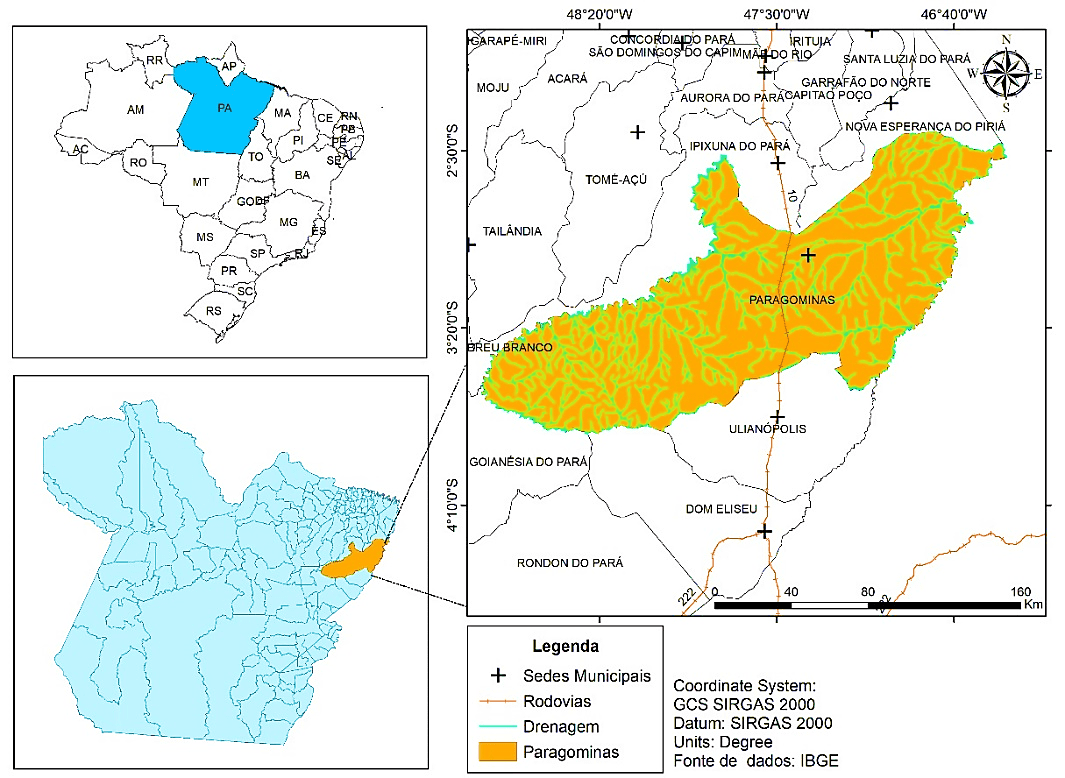
Regarding the geophysical characterization of the municipality, the climate is classified as Aw (tropical rainy with well-defined dry season), with annual averageprecipitation, relative humidity and temperature of 1,743 mm, 81% and 26.3 °C, respectively, with a view to the period from July to November low water availability; the vegetation is classified into subperenifolian submontane subperenifolian equatorial forest, dense equatorial forest of the lowlands and dense alluvial perenifolian equatorial forest; has an average altitude of 89 m; the soil is predominantly (95%) yellow latosol type, and the hydrographic network is composed of two main basins: the Capim river and the Gurupi river (PINTO et al., 2009).
One of the main economic activities in force is focused on agriculture, where the predominant crops are soybean (Glycine spp.), corn (Zea mays L.), cassava (Manihot esculenta Crantz) and sunflower (Helianthus annuus L.). The municipality differs greatly from the others in the region in terms of how to practice agriculture, and in the rigging of properties, since it is normal to find producers who use a high technological level (ALVES; CARVALHO; SILVA, 2014).
However, similar to the areas cultivated with grains in the Amazon, in this municipality, the conventional or traditional cultivation system is practiced. This is characterized by the intensive use of mechanization and monoculture, leaving, in most times, the exposed soil, having as consequences the loss of organic matter and erosion (SOUZA et al., 2017).
4. RESULTS AND DISCUSSION
4.1 AS FAR AS SOYBEAN PRODUCTION
The data obtained on soybean production indicated that there was a trend of growth in soybean production in Paragominas during the period analyzed, i.e., from 2008 to 2016 (Figure 02).
Figure 2 – Evolution of the soybean planted area in the municipality of Paragominas – PA.
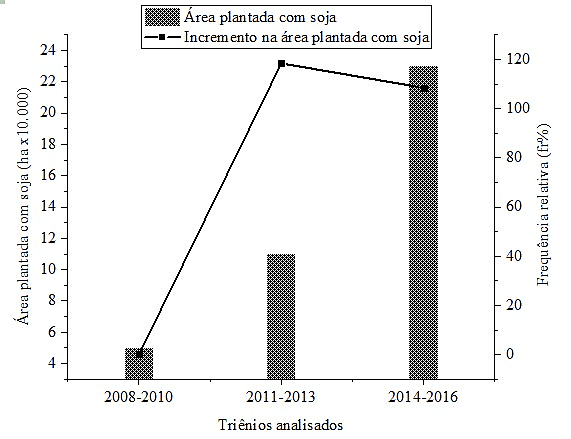
It was noticed, from the data analysis, that in the first triennium (2008-2010) the planted area of soybean corresponded to 52,520 ha; in the second triennium (2011-2013), the area destined for soybean cultivation was equivalent to 114,720 ha (118.43%). Finally, in the third triennium (2014-2016) the planted area corresponded to 239,163 ha (108.47%), with an involutive trend (-9.96%).
Studies carried out in the municipalities of Aceguá, Bagé and Dom Pedrito (RS), carried out by Kuplich; Capone, Capone; Costa (2018) corroborated the study conducted in the municipality of Paragominas (PA), because they concluded that the planted area of soybean in 2015 was, respectively, 250, 52 and 38 times higher in relation to the first year of analysis (2000). According to the study, in Aceguá the planted area of soybean in 2015 increased 1,150% compared to 2005; in the municipality of Bagé, the planted area between 2005 and 2015 grew about 191.7%. And in the municipality of Dom Pedrito, in 2015, the planted area increased 204% and was distributed throughout the municipality. In the research conducted in Paragominas, it was found that there was a parallel growth between 2008 and 2016.
Another study that was carried out by Brochado (2017), in the municipality of Santana do Araguaia (PA), most areas previously destined for pasture, are focused on soybean cultivation. In Pará, oilseed production is mainly concentrated in the municipalities of the southern region and also has significant production in the municipality of Santarém, in the Lower Amazon region. In the municipalities of Paragominas, Dom Eliseu, Ulianópolis and Rondon do Pará, the 2016 harvest reached about 180,000 ha of soybean planted area. Therefore, it was evident that the growth of sojiculture in the municipality analyzed is not the work of chance.
4.2 AS FAR AS THE UNFORWEED AREA
Regarding the deforested area in the municipality of Paragominas, it was observed, through the data, that there was a tendency to the growth of the total area in the three-year periods analyzed (Figure 3).
Figure 3 – Evolution of the deforested area in the municipality of Paragominas – PA.
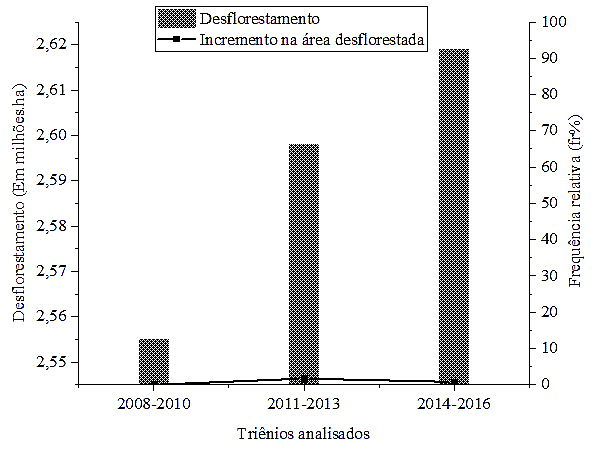
It was found, from the analysis of the data, that in the first triennium (2008-2010) the deforested area corresponded to 2,555,710 ha; in the second triennium (2011-2013) reached 2,598,920 ha (1.69%). Finally, in the third triennium (2014-2016) deforestation corresponded to 2,619,570 ha (0.79%), with an involutive trend (- 0.9%). The data also indicated that, despite the growth trend of the deforested area, there was a downward trend between the second and third triennium, which denotes the presence of the performance of municipal regulatory measures, which contributed to the reduction in deforestation rates.
In the research conducted by Delazeri (2016), in the municipalities of Pará that make up the Deforestation Arc (Altamira, Brasil Novo, Cumaru do Norte, Dom Eliseu, Itupiranga, Marabá, Novo Progresso, Novo Repartimento, Pacajá, Paragominas, Rondon do Pará, Santa Maria das Barreiras, Santana do Araguaia, São Félix do Xingu, Thailand and Ulianópolis), it was indicated that the drop in deforestation rates can be attributed to environmental policies (Action Plan for Prevention and Control of Deforestation in the Legal Amazon (PCDAm), introduced in the second half of the 2000s. In Paragominas, this process occurred in 2008, from the implementation of the “Green Municipality Project”, with the elaboration of a pact against deforestation between the government and local society.
In the annual analysis of the data obtained, it was found that between 2008 and 2016, a trend towards growth in the deforested area, since, in 2008, this rate was equivalent to 841,540 ha and, eight years later, evolved to 875,350 ha in 2016, i.e., an increase of 4.01% in this period.
The study conducted by Pamplona (2017), in the municipality of Barreiras – BA, concluded that the evolution of deforestation in the period from 1990 to 2016 showed an evolutionary trend of 24% and, in a more detailed analysis, this author added that, in 1990, the rate was equivalent to 13% , however, 26 years later, there was an evolution to 37%, with a variation equivalent to 24%. This study also concluded that, between 2010 and 2016, the rate of deforestation increase corresponded to 7%, and was the period with the highest growth compared to previous years. Finally, the author concluded that, in the analyzed interval, 59,507.2 ha of native vegetation areas were deforested, which indicated a trend of continuity of agricultural expansion in the study area.
In a survey conducted by Mengatto Junior; Olive tree; Silva (2017) in the municipality of Marabá – PA, the evaluation of data from PRODES Digital for the municipality indicated that there was an increase in deforested areas, mapped over fifteen years analyzed (2000 to 2015), as it evolved from 5,818.9 km² in 2010 to a total of 8,533.5 km² in 2015. Regarding the rate of increase in deforestation, in Marabá there was an increase of 46.6%, already in the municipality of Paragominas – PA, this increase was 4.01%.
4.3 AS FOR POSITIVE AND NEGATIVE EXTERNALITIES IN THE MUNICIPALITY OF PARAGOMINAS – PA
4.3.1 GDP GROWTH PER CAPITA
Regarding the relationship between the advance value of soybean production, there was also a propensity to evolve in the GDP of the municipality of Paragominas (Table 2).
Table 2 – Soybean production and GDP data in the municipality of Paragominas – PA.
| Year | Soybean production (t.) | PIB (R$) |
| 2008 | 35.160 | 4.290.238.000 |
| 2009 | 42.600 | 3.467.596.000 |
| 2010 | 71.820 | 6.453.706.230 |
| 2011 | 119.515 | 7.322.330.400 |
| 2012 | 123.740 | 4.598.608.690 |
| 2013 | 121.800 | 3.095.759.160 |
| 2014 | 121.800 | 5.605.753.640 |
| 2015 | 275.500 | 6.684.730.690 |
Source: prepared by the authors (2018) from data contained in IBGE (2017 b).
The data indicated an evolution of local GDP, from R$ 4,290,238,000.00, with soybean production equivalent to 35,160 tons in 2008, to a GDP of R$ 6,684,730,690.00, with soybean production equal to 275,500 tons in 2015. As for the analysis of specific data on the GDP of Paragominas, this indicates that, from 2008 to 2015 there was an increase of 55.81%. In this case, GDP growth in the municipality may be directly related to the advance of soybean production, since this activity also showed a growth rate (52,520 ha to 239,163 ha) in the three three years analyzed (2008-2010; 2011-2013; 2014-2016).
The research conducted in Dom Pedrito (RS), by Borges; Simons; Trindade (2016), indicated that the municipality presented good socioeconomic indexes, with gdp passing of R$ 605,054,586.00 and soybean production equivalent to 39,600 tons in 2008, to R$ 977,858,471.00 and soybean production equal to 180,900 tons in 2013. As in Dom Pedrito – RS, the benefits of oilseed production in Paragominas – PA, is reflected in the local economy, so the good performance of GDP is a positive externality, coming from large-scale grain production in the municipality.
4.3.2 EVOLUTION OF SCHOOL ENROLMENTs, NUMBER OF SCHOOLS AND TEACHERS HIRED
Regarding the evolution of school enrollments, number of schools and teachers hired in the city of Paragominas, the data analyzed indicated a downward trend in these requirements (Figure 4).
Figure 4 – Evolution of the number of enrollments made, number of schools and teachers contracts in Paragominas – PA.
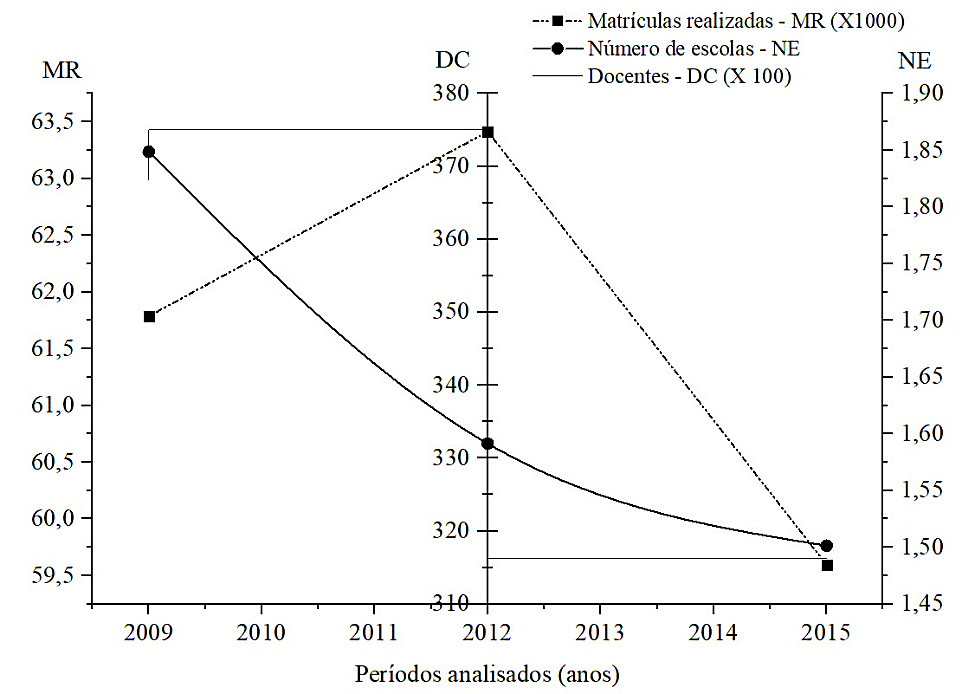
As for the analysis of data related to the number of enrollments, schools and teachers, it is noteworthy that:
(1) There was a variation in the number of enrollments in the years observed, with 61,786,000 enrollments in 2009, 63,414 thousand in 2012 and 59,596,000 in 2015;
(2) there was a decrease in the number of schools, as in 2009 there were 372 in 2012, which fell to 332, while in 2015, it counted only 318 schools and,
(3) in relation to the number of teachers hired, in 2009 there were a total of 1,824, 1,868 in 2012 and, in 2015, there were 1,490 teachers hired.
Regarding the number of enrollments made and teachers hired in the municipality, it was perceived a higher performance of these requirements in 2012. That same year, the value of soybean production grew by more than 56% compared to the previous year, so there was an increase in the GDP of agriculture; however, the increase in soybean yield represented only 3% of the GDP of the municipality of Paragominas. Thus, it did not represent a significant increase for the municipal GDP, and thus, it was not a determining factor for the increase in the number of enrollments and hiring of teachers. This increase in this year may be linked to factors such as the better development of other economic sectors (e.g., logging, coal production, reforestation, bauxite mining, industry and services), which were not the object of this Study.
A study in the municipality of Porto Nacional (TO), carried out by Silva and Rodrigues (2016), analyzed the main social impacts generated in the municipality due to soybean cultivation for biodiesel production and linked the higher revenue to improvements in Education. The study concluded that the higher the revenue of the municipality, the greater the availability of public services and, consequently, the greater the urban infrastructure. Thus, there would be an increase in educational infrastructure and decrease school dropout. In the municipality of Paragominas, this chain effect was not evident, because, in the years with better economic development, in the period analyzed, there was a decrease in important factors for education, that is, investment in this sector does not make a positive externality arising from the evolution of sojiculture in the municipality.
4.3.3 CORRELATION BETWEEN SOYBEAN PLANTED AREA AND UNFORWEED AREA
Pearson’s Correlation allowed us to verify the relationship of significance between the planted area with soybean cultivation and the deforested area in the municipality of Paragominas (Figure 05).
Figure 5 – Correlation between soybean planted area and deforested area in the municipality of Paragominas – PA.
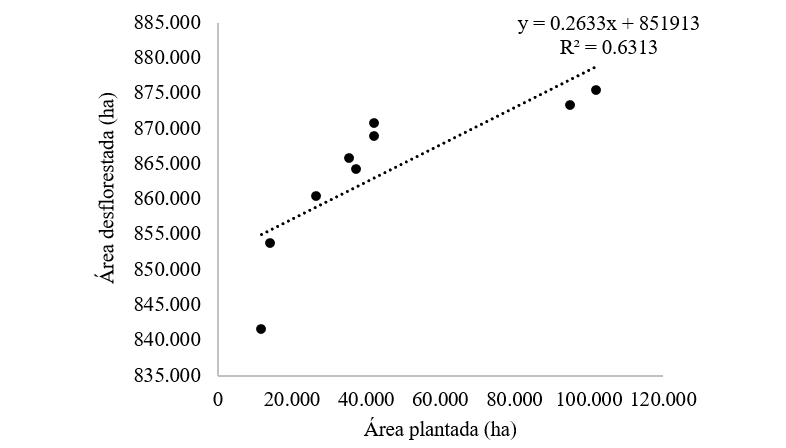
For the analysis of soybean planted area and deforested area, the data indicated a positive correlation qualified as strong (r = 0.81). These data allow us to infer that there is a direct relationship between the totals of the soybean planted area and the increase in deforestation in hectares, that is, how much it was deforested each year, with regard to the agricultural development process in Paragominas.
The studies conducted in the municipalities below (Table 3) present a Pearson correlation (r) established in the range of 0.81 to 0.99.
Table 3 – Pearson Coefficient Values (r) in municipalities in the states of: Mato Grosso – MT and Pará – PA.
| Municipalities | r |
| Sinop – MT | 0,85 |
| Sorriso – MT | 0,99 |
| São Félix do Xingu – PA | 0,81 |
Sources: Brum; Dalfovo, Dalfovo; Benfica (2011), Giaretta (2017) and Magno et al. (2013).
The values of (r) found by Brum; Dalfovo, Dalfovo; Benfica (2011) in the municipality of Sinop. in Mato Grosso, (r = 0.85); Giaretta (2017) in Sorriso, in the same state (r = 0.99), and Magno et al. (2013) in São Félix do Xingu, Pará (r = 0.81), were consonants to that found in Paragominas (r = 0.81), as there was a strong correlation between the trends of increase in the area occupied by soybean planting and the deforested area (established in the 0.81 to 0.99). In Paragominas, the deforested area and the area for oilseed cultivation increase in practically the same proportion, so deforestation is a negative externality derived from the advance of sojiculture in the municipality.
4.3.4 CORRELATION BETWEEN DEFORESTATION AND TOTAL RAINFALL
The data obtained and analyzed for deforestation and total rainfall in Paragominas showed growth trends for deforestation and decrease for precipitation in the three-year periods analyzed (Figure 06).
Figure 6 – Relationship between deforestation and total rainfall in Paragominas – PA.
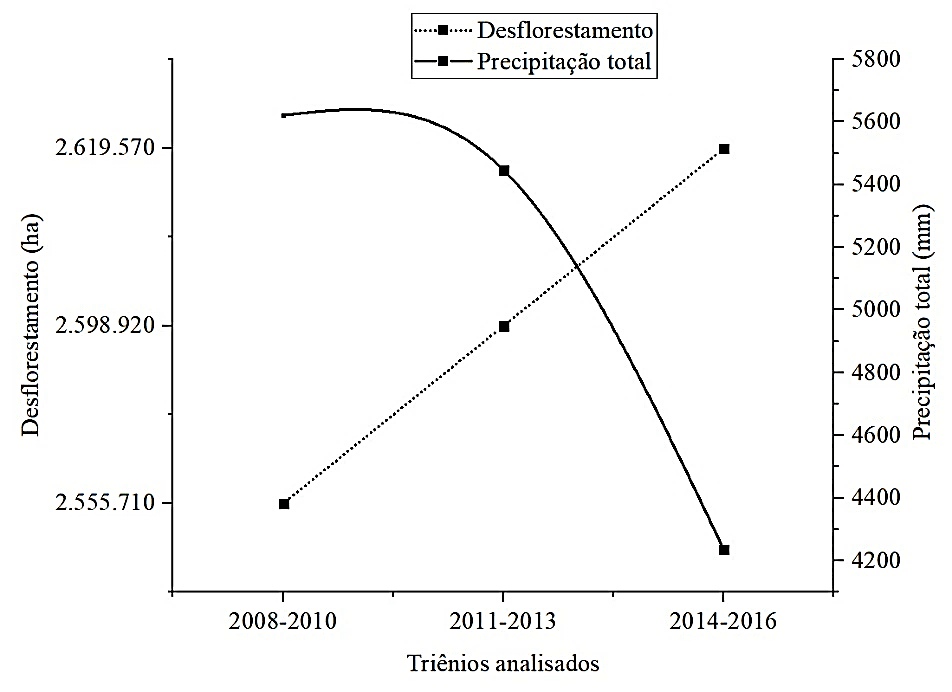
The precipitation variation reached extreme levels, with a maximum of 5,621.4 mm in the first triennium (2008-2010), and a minimum of 4,234.6 mm in the third triennium (2014-2016). However, the variation in precipitation may be related to several factors besides deforestation, such as the presence of La Niña and anthropic activities.
Regarding the analysis of Pearson’s correlation (r) between the variables deforestation and precipitation, the data indicated that there is an inversely proportional relationship (r = – 0.37), therefore, adjective as a weak relationship, that is, they have a certain independence between them. Thus, deforestation does not significantly influence the level of precipitation in the municipality of Paragominas (PA).
The study of Santos, C; Satyamurty, Satyamurty; Santos, E. (2012), carried out in Manaus (AM), concluded that, in the Amazon context, climate change may be related both to activities related to land use and occupation, as well as to natural phenomena such as El Niño and La Niña. In the municipality of Paragominas, atmospheric conditions, especially precipitation, may be related to global climatic variations resulting from natural causes. Thus, deforestation is not the main causative agent of local precipitation variation, therefore, it is not considered a negative externality due to the advance of soybean monoculture.
Therefore, one of the ways to mitigate the main externality caused by soybean monoculture, deforestation, is to apply cultivation techniques considered more sustainable, which promote balance in land use for economic activity, such as , No-tillage, followed by Seed Inoculation for Biological Nitrogen Fixation (BNF). Thus, with the increase in grain productivity, there will be no need to open new areas for cultivation in order to supply the production demand (BULEGON et al., 2016; LOSS et al., 2011).
Another is the use of already deforested areas is one of the factors that can increase the increase in this type of action and, thus contribute to the conservation of native plant biomass, avoid the loss of new habitats, as well as determine the conservation of the biological diversity of this municipality, besides contributing to the conservation of permanent preservation areas (PPAs), especially the two municipal water bodies (Uraim River and Paragominas/Prainha River).
5. CONCLUSION
Sojiculture generated externalities to the society in which it was inserted. Among them, the increase in municipal GDP, from the increase in the local economy caused by sojicultura in the period from 2008 to 2016.
Regarding the negative externalities, the correlation between the advance of the soybean planted area and deforestation in Paragominas was proven. However, it should be emphasized that there may be other variables such as livestock, logging and the production of other crops in the municipality, which influenced the increase of the deforested area, but which were not analyzed in this Research.
The data generated by this study, referring to the increase in the planted area of soybean, the increase in the deforested area and the municipal GDP, the change in the number of enrollments made and hired teachers, the decrease in the number of schools and the variation of precipitation, are real and will enable the continuation of future studies involving the dynamics of sojiculture.
REFERENCES
ABDALA, K. O.; RIBEIRO, F. L.; FERREIRA M. E. Risco de impactos ambientais gerados pela dinâmica de uso do solo. Revista Brasileira de Cartografia, Monte Carmelo, v. 68, n. 2, p. 235-252, 2016.
AGÊNCIA NACIONAL DE ÁGUAS. PORTAL – ANA. Portal HidroWeb. Disponível em: <http://www.snirh.gov.br/hidroweb/publico/apresentacao.jsf>. Acesso em: 22/95/2018.
ALMEIDA, L. C. B. Teoria economia ecológica. In: Pereira, R. S. (Org.). Gestão para o desenvolvimento econômico sustentável. São Paulo: Globus, 2013.
ALVES, L. W. R.; CARVALHO, E. J. M.; SILVA, L. G. T. Diagnóstico agrícola do município de Paragominas, PA. Belém: Embrapa- Amazônia Oriental, 2014.
ANTUNES, D. Externalidades negativas sobre o meio ambiente: processos econômicos de custeio. Revista de Ciências Gerenciais, São Paulo, v.13, n. 18, p.57-73, 2009.
ARAÚJO, R. C. Análise sobre a monocultura de soja e o desenvolvimento sustentável na Amazônia com base na teoria do desenvolvimento endógeno. Revista Economia e Desenvolvimento, Santa Maria v. 26, n. 1, p.106-118, 2014.
ARAÚJO, R. C.; PONTE, M. X. Agronegócios na Amazônia: ameaças e oportunidades para o desenvolvimento sustentável da região. Revista de Ciências Agroambientais, Alta Floresta, v. 13, n. 2, p.101-114, 2015.
ARTAXO, P. et al. Perspectiva de pesquisas na relação entre clima e o funcionamento da floresta amazônica. Ciência e Cultura, Campinas, v. 66, n. 3, p. 41-46, 2014.
AYRES, M. et al. BioEstat 5.0: aplicações estatísticas nas áreas das ciências biológicas e médicas. Belém: MCT; IDSM; CNPq, 2007. 364 p. il. Acompanha CD-ROM.
BALBINOT JUNIOR, A. A. et al. Análise da área, produção e produtividade da soja no Brasil em duas décadas (1997-2016). Londrina – PR: Embrapa Soja, 2017.
BORGES, S. C.; SIMÕES, F. S. B.; TRINDADE S. L. A Relação entre a Produção de Soja e o PIB no município de Dom Pedrito/Rs. Revista Agropampa, Dom Pedrito, v.1, n. 2, p. 169-180, 2016.
BROCHADO, M. L. C. Avaliação de cenários de desmatamento para o estado do Pará. 2017, 44 p. Dissertação (Mestrado em geografia) – Universidade de Brasília – UNB, Brasília – DF, 2017.
BRUM, A. L.; DALFOVO, W. C. T.; AZUAGA, F. L. Alguns impactos da expansão da produção de soja no município de Sorriso-MT. Revista Desenvolvimento em Questão, Ijuí,v. 7, n. 14, p. 173-200, 2009.
BRUM, A. L.; DALFOVO, W. C. T.; BENFICA, V. C. A relação entre o desenvolvimento e o crescimento das culturas de grãos no município de Sinop-MT: uma análise para o período de 1984 a 2009. Revista Desenvolvimento em Questão, Ijuí, v. 9, n. 17, p.159-190, 2011.
BULEGON, L. G. et al. Componente de produção e produtividade da cultura de soja submetida à inoculação de Bradyrhizobium e Azospirillum. Revista Terra Latinoamericana, Chapingo – Estado do México, v. 34, n. 2, p. 169-176, 2016.
CPT. Comissão Pastoral da Terra Relatório. “Conflitos no campo 2016”. 2016. Disponível em:<https://www.cptnacional.org.br/component/jdownloads/summary/41-conflitos-no-campo-brasil-publicacao/14061-conflitos-no-campo-brasil-2016>. Acesso em: 08/06/2018.
DALL’AGNOL, A. A soja no brasil: evolução, causas, impactos e perspectivas. Congresso de la soja del Mercosur, 5.; FORO DE LA SOJA ASIA, 1, Rosario. Un grano: Un universo. [Rosário: Asociación de la cadena de la soja Argetina], 2011.Disponível em: <http://ainfo.cnptia.embrapa.br/digital/bitstream/item/47515/1/amelio.soja.2011.pdf>. Acesso em: 08/06/2018.
DELAZERI, L. M. Determinantes do desmatamento nos municípios do Arco Verde – Amazônia Legal: uma abordagem econométrica. Revista Economia-Ensaios, Uberlândia, v. 30, n. 2, p. 11-34, 2016.
DERANI, C.; SCHOLZ, M. C. A Injustiça ambiental das externalidades negativas das monoculturas para commodities agrícolas de exportação no Brasil. Revista Direito Agrário e Agroambiental, Maranhão, v. 3, n. 2, p. 1-25, 2017.
DEUS, R. M.; BAKONYI, S. M. C. O. Impacto da agricultura sobre o meio ambiente. Revista Eletrônica em Gestão, Educação e Tecnologia Ambiental, Santa Maria, v. 7, n. 7, p. 1306-1315, 2012.
DOMINGUES, M. S.; BERMANN, C. O Arco do desflorestamento na Amazônia: da pecuária à soja. Ambiente e Sociedade, São Paulo, v. 15, n. 2, p. 1-22, 2012.
EMBRAPA. Empresa Brasileira de Pesquisa Agropecuária. Perspectiva agrícolas no Brasil: desafios da agricultura brasileira 2015-2024. Capítulo 2 – Agricultura Brasileira: perspectivas e desafios. Brasília – DF: OCDE: FAO, 2015. 51p. Disponível em: <http://www.agri-outlook.org/>. Acesso em: 12/11/2017.
FERNANDES, P. A.; PESSÔA, V. L. S. O Cerrado e as suas atividades impactantes: uma leitura sobre o garimpo, a mineração e a agricultura mecanizada. Revista Eletrônica de Geografia, Rio Claro, v. 3, n. 7, p. 19-37, 2011.
FIRMINO, R. G.; FONSECA, M. B. Uma visão econômica dos impactos ambientais causados pela expansão da agricultura. Revista Econômica e Administração, São Paulo, v. 9, n. 18 p. 32-48, 2008.
FREDERICO, S. As cidades do agronegócio na fronteira agrícola moderna brasileira. Caderno Prudentino de Geografia, Presidente Prudente, v. 1, n. 33, p. 5-23,2011.
GAZZONI, D. L. A sustentabilidade da soja no contexto do agronegócio brasileiro e mundial. Londrina – PR: Embrapa, 2013.
GIARETTA, J. Produção agropecuária e suas interações com fatores ambientais, sociais e econômicos no município de Sorriso – Mato Grosso. 2017, 55 p. Dissertação (mestrado em Ambiente e Sistema de Produção Agrícola) – Universidade do Estado de Mato Grosso – UNEMAT, Tangará da Serra, 55 p, 2017.
GONZALEZ, R. A. et al. A influência do evento El Niño-Oscilação Sul e Atlântico Equatorial na precipitação sobre as regiões Norte e Nordeste da América do Sul. Revista Acta Amazônica, Manaus, v. 43, n. 4, p. 469-480, 2013.
GRANZIERA, M. M.; SAES, M. S. M. Um estudo da contribuição da agricultura multifuncional para o desenvolvimento rural sustentável. Revista de Gestão Ambiental e Sustentabilidade, São Paulo, v. 3, n. 1, p. 60-70, 2014.
IBGE. Instituto Brasileiro De Geografia E Estatística. Bases Cartográficas. Brasília, DF. 2017a. Disponível em: <https:// mapas.ibge.gov.br/bases-e-referenciais/basescartograficas/mapas-municipais>. Acesso em: 02 mai. 2018.
IBGE. Instituto Brasileiro De Geografia E Estatística. Cidades@. Brasília, DF. 2017b. Disponível em: < https://cidades.ibge.gov.br/ >. Acesso em: 20/10/2017.
INPE. Instituto Nacional de Pesquisas Espaciais. PRODES DIGITAL, Desflorestamento nos Municípios da Amazônia Legal para o ano de 2016. 2017. Disponível em: <http://www.dpi.inpe.br/prodesdigital/prodesmunicipal.php>. Acesso em: 18/ 10/2017.
IRIGARAY, C. T. et al. O Pantanal Matogrossense enquanto patrimônio nacional no contexto das mudanças climáticas. In: SILVA, S. T., CUREAU, S.; LEUZINGER, M. (Orgs.). Mudança do Clima. Desafios jurídicos, econômicos e socioambientais. São Paulo: Fiuza, 2011.
KUPLICH, T. M.; CAPONE, V.; COSTA, L. F. F. O avanço da soja no Bioma Pampa. Boletim Geográfico do Rio Grande do Sul, Porto Alegre, v. 32, n. 31, p. 83-100, 2018.
LOSS, A. et al. Agregação, carbono e nitrogênio em agregados do solo sob plantio direto com integração lavoura-pecuária. Pesquisa Agropecuária Brasileira, Brasília, v. 46, n. 10, p. 1269-1276, 2011.
MAGNO, R. A. M. et al. Configuração espacial do desflorestamento em fronteira agrícola na Amazônia: um estudo de caso na região de São Félix do Xingu, estado do Pará. Revista Nera, Presidente Prudente, v. 16, n. 22, p. 96-110, 2013.
MATOS, P. F.; PESSÔA V. L. S. O Agronegócio no Cerrado do Sudeste Goiano: uma leitura sobre Campo Alegre de Goiás, Catalão e Ipameri. Sociedade e Natureza, Uberlândia, v. 24, n. 1, p. 37-50, 2012.
MENGATTO JUNIOR, E. A.; OLIVEIRA, R. C.; SILVA, J. O município de Marabá, PA frente ao ZEE na Amazônia Legal: avaliação das taxas de desmatamento. Embrapa Informática Agropecuária-Artigo em anais de congresso (ALICE). SIMPÓSIO BRASILEIRO DE GEOGRAFIA FÍSICA APLICADA, 17.; CONGRESSO NACIONAL DE GEOGRAFIA FÍSICA, 1., 2017, Campinas. Os desafios da geografia física na fronteira do conhecimento. Campinas: Unicamp, 2017.
MIRANDA, R. S. O Agronegócio da soja no Brasil: do Estado ao capital privado. Revista Novos Rumos Sociológicos, Pelotas, v. 2, n. 2, p. 122-141, 2014.
NOBRE, C. A. et al. Características do Clima Amazônico: Aspectos Principais. In: Keller, M. et al. (Eds). Amazonia and Global Change. Washington, DC: Geophysical Monograph, jan. 2019, p. 149-162.
OLIVEIRA NETO, A. A. Acompanhamento da safra brasileira. Companhia Nacional do Abastecimento (CONAB): Sexto levantamento, março 2017 – safra 2016/2017.: Brasília: Companhia Nacional de Abastecimento, 2017. Disponível em: < http://www.conab.gov.br>. Acesso em: 13/11/2017.
OLIVEIRA, C. M.; SANTANA, A. C. A governança no Arranjo Produtivo de Grãos de Santarém e Belterra, estado do Pará: uma análise a partir do grão soja. Revista de Economia e Sociologia Rural. Brasília, v. 50, n. 4, p. 683-704, 2012.
PAMPLONA, N. L. Mudanças no uso e cobertura da terra no município de Barreiras – BA entre 1990 e 2016. 2017. 44 p. Monografia (Graduação em Engenharia Ambiental) – Faculdade de Tecnologia, Universidade de Brasília. Brasília – DF. 2017.
PINTO, A. et al. Diagnóstico Socioeconômico e Florestal do município de Paragominas. Relatório Técnico. Belém – PA: Imazon, 2009.
PORTO. M. L.; JESUS, E. S.; PEREIRA JÚNIOR, A. Análise das tendências nas relações entre fluxo de veículos, arborização e os níveis de intensidade de ruído. Ecologia e Nutrição Florestal, Santa Maria, v.5, n. 3, p. 87-97, 2017.
PRODANOV, C. C.; FREITAS, E. C. Metodologia do trabalho científico: métodos e técnicas da pesquisa e do trabalho acadêmico. 2 ed. Novo Hamburgo – RS: Universidade Feevale, 2013.
QUEIROZ, F. A. Impactos da sojicultura de exportação sobre a biodiversidade do Cerrado. Sociedade e Natureza, Uberlândia, v. 21, n. 2, p. 193-209, 2009.
RIVERO, S. et al. Pecuária e desmatamento: uma análise das principais causas diretas do desmatamento da Amazônia. Nova Economia, Belo Horizonte, v. 19, n. 1, p. 41-66, 2011.
SAKAMOTO, C. K.; SILVEIRA, I. O. Como fazer projetos e Iniciação Científica. São Paulo : PAULUS, 2014.
SANTOS, C. A. C.; SATYAMURTY, P.; SANTOS E. M. Tendências de índice de extremos climáticos para a região de Manaus-AM. Acta Amazonica, Manaus – AM, v. 42, n. 3, p.329-336, set. 2012.
SANTOS, S. R. Q. et al. Regime térmico e hídrico do solo para área de floresta tropical em anos de El Niño e La Niña, Caxiuanã-PA: estudo de caso. Revista Brasileira de Meteorologia, São Paulo, v. 26, n. 3, p. 367-374, 2011.
SEVERINO, A. J. Metodologia do trabalho científico. 24 ed. São Paulo: Cortez, 2017.
SILVA, C. A. F. Corporação e Agronegócio da soja na Amazônia. Revista ACTA Geográfica, Boa Vista, v. 2, n. 3, p.29-40, 2008.
SILVA, T. L. A.; RODRIGUES, L. H. Avaliação sistêmica dos impactos sociais da produção de soja para biocombustíveis na região central do estado de Tocantins. 2016. 140 p. Dissertação (mestrado em Engenharia de Produção e Sistemas) – Universidade do Vale do Rio dos Sinos, São Leopoldo – RS, 2016.
SILVEIRA, D. T.; CÓRDOVA, T. E. A pesquisa científica. In: Gerhardt, T. E.; Silveira, D. T. (Org.). Métodos de pesquisa. Porto Alegre: Editora de UFRGS, 2009, p. 31-42.
SOUZA, L. M. et al. Avaliação do uso e cobertura da terra em Paragominas e Ulianópolis – PA, utilizando dados do projeto TERRACLASS. Revista Brasileira de Cartografia, Uberlândia, v. 3, n. 3, p. 421-431, 2017.
SOUZA, P. J. O. P.; ROCHA, E. J. P.; RIBEIRO A. Impactos do avanço da soja no balanço de radiação no leste da Amazônia. Acta Amazônica, Manaus, v. 43, n. 2, p. 169-178, 2013.
[1] Graduated in Environmental Engineering. State University of Pará. Center for Natural Sciences and Technology.
[2] Graduated in Environmental Engineering. State University of Pará. Center for Natural Sciences and Technology.
[3] Graduated in Environmental Engineering. State University of Pará. Center for Natural Sciences and Technology.
[4] Graduating in Environmental Engineering. State University of Pará. Center for Natural Sciences and Technology.
[5] Doctor of Climate Science. State University of Pará. Center for Natural Sciences and Technology.
[6] Master in Environmental Sciences. State University of Pará. Center for Natural Sciences and Technology.
Submitted: November, 2019.
Approved: December, 2019.

